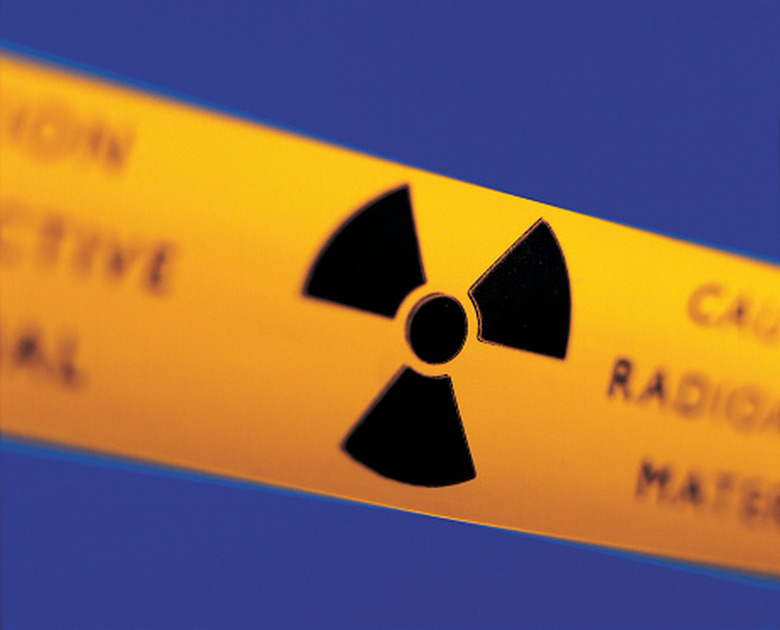How To Convert Grams To Curies
Radioactive elements undergo decay, and the speed at which the decay occurs used to be measured in curies. The International Council of Scientific Unions on Standards, Units and Constants of Radioactivity defined the curie as the "quantity of any radioactive substance in which 3.7 × 10^10 disintegrations occur each second." Decay rates vary between the different radioactive elements, so the conversion of grams to curies, abbreviated to Ci, is possible only when the source material is known.
Step 1
Establish the atomic weight of the element by checking the periodic table. For example, the atomic weight of Cobalt-60 is 59.92 and Uranium-238 has the atomic weight 238.
Step 2
Convert the mass into moles, using the formula moles = mass of the element / atomic mass of the element, and then convert moles to atoms by multiplying the mole value by Avogadro's number, 6.02 x 10^23. For example, to establish the number of atoms in 1 gram of Cobalt-60, calculate (1 / 59.92) x (6.02 x 10^23). This resolves to 1.01 x 10^22 atoms.
Step 3
Substitute the activity of the element, for example 1.10 x 10^3 Ci for Cobalt-60, into the formula: r = activity rate x (3.700 x 10^10 atoms/s/Ci). The result is "r," the number of atoms decaying per second. For example, 1.10 x 10^3 x 3.700 x 10^10 = 4.04 x 10^13 atoms decaying per second, so r = 4.04 x 10^13.
Step 4
Use the first-order rate equation, r = k[number of atoms]1, to determine the value for k. For example, using the values for "r" and the number of atoms previously determined for Cobalt-60, the equation becomes: 4.04 x 10^13 atoms decaying per second = k[1.01 x 10^22 atoms]. This resolves to k = 4.1 x 10^-9 s^-1
Step 5
Determine the decay activity, in atoms / second, for the element. To do this, substitute the number of atoms in the sample into the equation: (4.1 x 10^-9 s^-1) x (number of atoms in the sample). For example, with 1.01 x 10^22 atoms the equation becomes : (4.1 x 10^-9 s^-1) x (1.01 x 10^22). This resolves to 4.141 x 10^13 atoms / second.
Step 6
Calculate the value in curies by dividing the decay rate per second by 3.7 x 10^10, the decay rate equal to 1 curie. For example, 1 gram of Cobalt-60 is equivalent to 1,119 curies because 4.141 x 10^13/ 3.7 x 10^10 = 1,119 Ci.
TL;DR (Too Long; Didn't Read)
Use a scientific calculator and perform all the calculations using scientific notation. This eliminates potential errors generated by incorrect numbers of zeros in very large numbers.
Warning
Step 4 involves calculus and will not be possible without advanced mathematical knowledge.
References
- Sizes: Curie
- Chemical Elements.com: Interactive Periodic Table Of The Elements
- Clackamas Community College; Theory Fundamentals – Atoms, Elements and Compounds; Mole-Gram Calculations; Sue Eggling
- "Calculations for A-level Chemistry – 3rd Edition"; E. N. Ramsden; 2001
- University of Washington Department of Mathematics; Radiation and Derivatives; Hart F. Smith Ph.D.; December 2002
Cite This Article
MLA
Robinson, David. "How To Convert Grams To Curies" sciencing.com, https://www.sciencing.com/convert-grams-curies-8692039/. 24 April 2017.
APA
Robinson, David. (2017, April 24). How To Convert Grams To Curies. sciencing.com. Retrieved from https://www.sciencing.com/convert-grams-curies-8692039/
Chicago
Robinson, David. How To Convert Grams To Curies last modified March 24, 2022. https://www.sciencing.com/convert-grams-curies-8692039/
